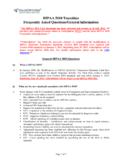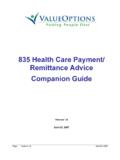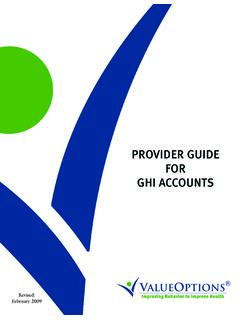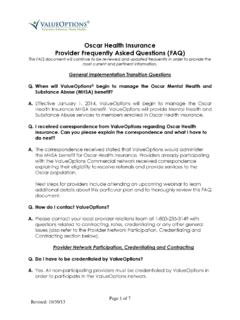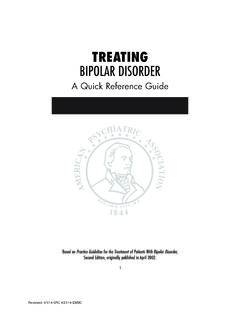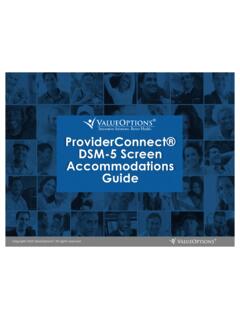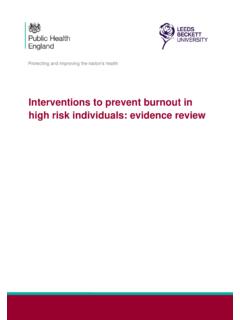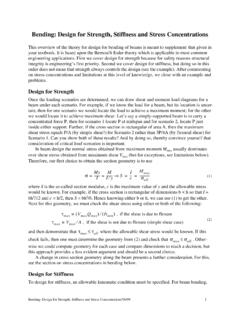Transcription of TREATING PATIENTS WITH ACUTE STRESS DISORDER AND ...
1 Based on Practice Guideline for the Treatment of PATIENTS With ACUTE STRESS DISORDER andPosttraumatic STRESS DISORDER , originally published in November 2004. A guideline watch,summarizing significant developments in the scientific literature since publication of this guideline,may be available in the Psychiatric Practice section of the APA web site at PATIENTS WITHACUTE STRESS DISORDER AND POSTTRAUMATIC STRESS DISORDERA Quick Reference GuideReviewed: 4/1/14-SRC / 4/21/14-EMMCA merican Psychiatric Association Steering Committee on Practice GuidelinesJohn S.
2 McIntyre, , ChairSara C. Charles, , Vice-ChairDaniel J. Anzia, A. Cook, T. Finnerty, R. Johnson, E. Nininger, Summergrad, M. Woods, , Yager, and Component LiaisonsRobert Pyles, (Area I)C. Deborah Cross, (Area II)Roger Peele, (Area III)Daniel J. Anzia, (Area IV)John P. D. Shemo, (Area V)Lawrence Lurie, (Area VI)R. Dale Walker, (Area VII)Mary Ann Barnovitz, Hafter Gray, Saxena, Tonnu, Editors, Quick Reference GuidesMichael B. First, J. Fochtmann, Kunkle, , Senior Program ManagerAmy B.
3 Albert, , Assistant Project ManagerClaudia Hart, Director, Department of Quality Improvement and Psychiatric ServicesDarrel A. Regier, , , Director, Division of ResearchReviewed: 4/1/14-SRC / 4/21/14-EMMCS tatement of IntentThe Practice Guidelines and the Quick Reference Guides are not intended to beconstrued or to serve as a standard of medical care. Standards of medical care aredetermined on the basis of all clinical data available for an individual patient andare subject to change as scientific knowledge and technology advance and practicepatterns evolve.
4 These parameters of practice should be considered guidelines to them will not ensure a successful outcome for every individual, norshould they be interpreted as including all proper methods of care or excludingother acceptable methods of care aimed at the same results. The ultimate judg-ment regarding a particular clinical procedure or treatment plan must be made bythe psychiatrist in light of the clinical data presented by the patient and the diag-nostic and treatment options development of the APA Practice Guidelines and Quick Reference Guideshas not been financially supported by any commercial organization.
5 For moredetail, see APA s Practice Guideline Development Process, available as an appen-dix to the compendium of APA practice guidelines, published by APPI, and onlineat : 4/1/14-SRC / 4/21/14-EMMC TREATINGASD AND PTSD206B. Psychiatric Management1. Evaluate the safety of the patient and others,including risk for Determine a treatment setting ..2103. Establish and maintain a therapeutic alliance ..2114. Coordinate the treatment effort ..2115. Monitor treatment response ..2116. Provide education ..2127.
6 Enhance adherence to treatment ..2128. Increase understandingof and adaptation to the psychosocial effectsof the Evaluate and manage physical health and functional impairments ..213 OUTLINEA. Initial Assessment1. Initial Clinical Approaches to the Patient ..2072. Assessing Exposure to a Traumatic Eventand Establishing a Principles of Treatment Selection1. Goals of Choice of Initial Treatment Approaches for PATIENTS Who Do Not Respond to Initial Treatment ..2164. Ethnic and Cultural Factors ..217D.
7 Specific Treatment Strategies1. Psychopharma-cology ..2182. Psychotherapy ..219 Reviewed: 4/1/14-SRC / 4/21/14-EMMCTREATINGASD AND PTSD 207A. Initial AssessmentConsider type of event and available resources. The timing and nature of initial assessments depends on the type oftraumatic event ( , sexual assault vs. natural disaster) and thescope of any destruction caused by the event. In large-scale catastrophes, the initial assessment may be the triageof individuals at greatest risk for psychiatric sequelae, includingacute STRESS DISORDER (ASD) or posttraumatic STRESS DISORDER (PTSD).
8 If local resources are overwhelmed by a catastrophe, psychiatricassessment will need to be prioritized so that the most severelyaffected individuals are seen the individual s requirements for medical care, rest, nutrition,and control of injury-related pain and establish a safe aware that in triage or emergency department settings, in-depthexploration of the traumatic event and the patient s experiences mayincrease distress but may be required for medical or safety Initial Clinical Approaches to the PatientRespond to individual needs and capabilities ( , prematureexploration of recent life-threatening events may lead some persons toavoid medical care, whereas others find in-depth exploration helpful).
9 Reviewed: 4/1/14-SRC / 4/21/14-EMMC TREATINGASD AND PTSD208 Screen for recent or remote exposure to a traumatic event (necessaryfor a diagnosis of ASD or PTSD).2. Assessing Exposure to a Traumatic Event and Establishing a DiagnosisConsider limitations in making a diagnosis. Dissociative symptoms may prevent PATIENTS from recalling feelingsof fear, helplessness, or horror. Initial assessment may occur in a triage setting immediately afterthe trauma and before all symptoms are determining that the traumatically exposed individual can toleratemore extensive evaluation, obtain a detailed history of the exposureand the patient s early the individual s response to the event as well as the nature ofthe event a history of all salient traumas (including the patient s age at thetime of the trauma and the duration of the trauma)
10 And factors orinterventions that may have intensified or mitigated the validating the clinical interview with a self-rated measure( , the PTSD Checklist).Reviewed: 4/1/14-SRC / 4/21/14-EMMCTREATINGASD AND PTSD 209 Conduct a complete psychiatric evaluation. Assess for symptoms of ASD and PTSD, including dissociative,reexperiencing, avoidance/numbing, and hyperarousal symptomclusters and their time of onset relative to the trauma. PTSD isdiagnosed if symptoms persist for at least 30 days after thetraumatic event; if the symptoms have been present for less than 30 days, and if dissociative symptoms are present, ASD may bediagnosed.
